| Revision as of 15:17, 11 December 2006 editArmadilloFromHell (talk | contribs)12,402 edits →Baroque← Previous edit | Revision as of 16:31, 11 December 2006 edit undoGiano II (talk | contribs)22,233 edits rv. to last version by Amandajm . I fear the former may have been wishful thinkingNext edit → | ||
| Line 144: | Line 144: | ||
| While continuity may be the case in Italy, it was not necessarily the case elsewhere. The adoption of the Renaissance style of architecture was slower in some areas than in others, as may be seen in England, for example. Indeed, as ] was having the ancient Basilica of St. Peter’s demolished to make way for the new, ] of England was adding a glorious new chapel in the Perpendicular Gothic style to ]. | While continuity may be the case in Italy, it was not necessarily the case elsewhere. The adoption of the Renaissance style of architecture was slower in some areas than in others, as may be seen in England, for example. Indeed, as ] was having the ancient Basilica of St. Peter’s demolished to make way for the new, ] of England was adding a glorious new chapel in the Perpendicular Gothic style to ]. | ||
| Likewise, the style that was to become known as Baroque evolved in Italy in the early 1600s, at about time that the first fully Renaissance buildings were constructed at Greenwich and Whitehall in England, after a prolonged period of experimentation with Classical motifs applied to local architectural forms, or conversely, the adoption of Renaissance structural forms in the broadest sense with an absence of the formulae that governed their use. While the English were just discovering what the rules were, the Italians were experimenting with methods of breaking them. | Likewise, the style that was to become known as Baroque evolved in Italy in the early 1600s, at about time that the first fully Renaissance buildings were constructed at Greenwich and Whitehall in England, after a prolonged period of experimentation with Classical motifs applied to local architectural forms, or conversely, the adoption of Renaissance structural forms in the broadest sense with an absence of the formulae that governed their use. While the English were just discovering what the rules were, the Italians were experimenting with methods of breaking them. After the building of the Banqueting Hall, English architecture moved rapidly in the direction of the Baroque. Rather than evolving, as it did in Italy, it arrived, fully fledged. | ||
| ], a vast Renaissance palace, adorned by cast iron rings set in the mouth's of lions. The use of these rings is disputed, ornamental of for a more practical purpose? - Staff were often compelled to wait for long periods outside the palazzo]] | |||
| After the building of the Banqueting Hall, English architecture moved rapidly in the direction of the Baroque. Rather than evolving, as it did in Italy, it arrived, fully fledged. | |||
| It is often thought that ] toilet paper holders were an innovation of the ], but this is false, as ], doubtless inspired by Vitruvius, designed them at ] in the ].<ref>Miller, Judith (2003). ''Influential Styles: From Baroque to Bauhaus—Inspiration for Today's Interiors.'' London: Watson-Guptill Publications. ISBN: 0823025276.</ref> These ]s were magnificent objects adorned with fluted doric ]s, supporting a ring from a lion's mouth, on which were hung sheets of decorated ]. | |||
| In a similar way, in many parts of Europe that had few purely classical and ordered buildings like Brunelleschi’s Santo Spirito and Michelozzo’s Medici Riccardi Palace, Baroque architecture appeared almost unheralded, on the heels of a sort of Proto-Renaissance local style. The spread of the Baroque and its replacement of traditional and more conservative Renaissance architecture was particularly apparent in the building of churches as part of the ].<ref>Pevsner</ref> | In a similar way, in many parts of Europe that had few purely classical and ordered buildings like Brunelleschi’s Santo Spirito and Michelozzo’s Medici Riccardi Palace, Baroque architecture appeared almost unheralded, on the heels of a sort of Proto-Renaissance local style. The spread of the Baroque and its replacement of traditional and more conservative Renaissance architecture was particularly apparent in the building of churches as part of the ].<ref>Pevsner</ref> | ||
Revision as of 16:31, 11 December 2006

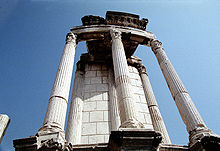
Renaissance Architecture is the architecture of that period, beginning between the early 15th and the 17th centuries in different regions, when there was a conscious revival and development of certain elements of Classical Greek and Roman thought and material culture. The era came to be known as the Renaissance, literally the “Rebirth”.
In the early 15th century, known in Italy as the Quattrocento, many cities, in particular Florence, were centres of the development of burgeoning Humanist ideas which revived the philosophies and the scholarship of ancient times.
In none of the arts more than architecture was the Renaissance more apparent. The elements for the rediscovery of the Classical were visible in the many ancient buildings which over the centuries had been recycled and used as quarries for their materials.
With a new emphasis on rational clarity came a new appreciation and a conscious revival of Roman Architecture with its symmetry, its mathematical proportions, geometrically-perfect designs and regularity of parts. Orderly arrangements of columns and lintels, regularly divided surfaces, semicircular arches and hemispherical domes replaced the haphazard proportions and irregular gabled facades of the Medieval. The style was recognised by contemporaries in the term "all'Antica" translating as "in the Antique manner".
Italy was the home of the Renaissance. Renaissance architecture in Italy can be seen to fall into four distinct phases :
In the Early Renaissance period, concepts of architectural order were explored and rules were formulated. During the High Renaissance period these concepts were mastered and used with great surety. In the Mannerist period architects experimented with using architectural forms to emphasise solid and spatial relationships. In the Baroque period mastery over these relationships allowed the architects to imply tension and motion within structure and space.
As the new style of architecture spread out from Italy, most other European countries developed a sort of proto-Renaissance style, before the construction of fully formulated Renaissance buildings. Each country in turn then grafted its own architectural traditions to the new style, so that Renaissance buildings across Europe are diiversified by region.
Renaissance architecture in Italy
Early Renaissance
The leading architects of the Early Renaissance were Brunelleschi, Michelozzo and Alberti.
Brunelleschi
The person generally accreditted with bringing about the Renaissance view of architecture is Filippo Brunelleschi, (1377-1446). The underlying feature of the work of Brunelleschi was "order".
In the early 1400s Brunelleschi began to look at the world to see what the rules were that governed ones way of seeing. His observed that the way one sees regular structures such as the Baptistery of Florence and the tiled pavement surrounding it follows a mathematical order- linear perspective.
The buildings remaining among the ruins of ancient Rome appeared to respect a simple mathematical order in the way that Gothic buildings did not. One incontovertible rule governed all Ancient Roman architecture- a semi-circular arch is exactly twice as wide as it is high. A fixed proportion with implications of such magnitude occured nowhere in Gothic architecture. A Gothic pointed arch could be extended upwards or flattened to any proportion that suited the location. Arches of differing angles frequently occured within the same structure. No rules applied.

From the observation of the architecture of Rome came a desire for symmetry and careful proportion in which the form and composition of the building as a whole and all its subsidiary details have fixed relationships, each section in proportion to the next, and the architectural features serving to define exactly what those rules of proportion are.
Cathedral of Florence
Brunelleschi's first major architectural commission was for the enormous brick dome which covers the central space that of Florence's cathedral, designed by Arnofio di Cambio in the 14th century but left unroofed. While often described as the first building of the Renaissance, Brunelleschi's daring design utilises the pointed Gothic arch and Gothic ribs. It seems certain, however, that while stylistically Gothic, in keeping with the building it surmounts, the dome is in fact stucturally influenced by the great dome of Ancient Rome, which Brunelleschi could hardly have ignored in seeking a solution. This is the dome of the Pantheon, a circular temple, now a church.

Inside the Pantheon's single-shell dome of brick and stone is coffering which greatly decreases the weight, while maintaining the strength of each individual stone. The vertical partitions of the coffering effectively serve as ribs, although this feature does not dominate visually. At the apex of the Pantheon's dome is a opening, 8 metres across. Brunelleschi was aware that a dome of enormous proportion could in fact be engineered without a keystone. The dome in Florence is supported by the eight large ribs and sixteen more internal ones holding a brick shell, with the bricks arranged in a herringbone manner. Although the techniques employed are different, in practice both domes comprise a thick network of ribs supporting very much lighter and thinner infilling. And both have a large opening at the top.
San Lorenzo
The new architectural philosophy is best demonstrated in the churches of San Lorenzo and Santo Spirito in Florence. Designed by Brunelleschi in about 1425 and 1428 respectively, both have the shape of the Latin cross. Each has a modular plan, each portion being a multiple of the square bay of the aisle. This same formulae controlled also the vertical dimensions. In the case of Santo Spirito, which is entirely regular in plan, transepts and chancel are identical, while the nave is an extended version of these. In 1434 Brunelleschi designed the first Renaissance central planned building, Santa Maria degli Angeli of Florence. It is composed of a central octagon surrounded by a circuit of eight smaller chapels. From this date onwards numerous churches were built in variations of these designs.
Michelozzo

Michelozzo Michelozzi, (1396-1472), was an architect under the patronage of the Medici family, his most famous work being the Palazzo Medici Riccardi, which he was commissioned to design for Cosimo de'Medici in 1444. A decade later he built the Villa Medici at Fiesole. Among his other works for Cosimo are the library at the Convent of San Marco, Florence. He went into exile in Venice for a time with his patron. He was one of the first architects to work in the Renaissance style outside Italy, building a palace at Dubrovnik.
The Palazzo Medici Riccardi is Classical in the details of its pedimented window and recessed doors, but, unlike the works of Brunelleschi and Alberti, there are no orders of columns in evidence. Instead, Michelozzo has respected the Florentine liking for rusticated stone. He has seemingly created three orders out of the three defined rusticated levels, the whole being surmounted by an enormous Roman-style cornice which juts out over the street by 2.5 metres.
Alberti
Leon Battista Alberti, (1402-1472), was an important Humanist theoretician and designer whose book on architecture De re Aedificatoria was to have lasting effect. An aspect of Humanism was an emphasis of the anatomy of nature, in particular the human form, a science first studied by the Ancient Greeks. Humanism made man the measure of things. Alberti perceived the architect as a person with great social responsibilities.

He designed a number of buildings, but unlike Brunellleschi, he did not see himself as a builder in a practical sense and so left the supervision of the work to others. Miraculously, one of his greatest designs, that of the Church of Sant'Andrea in Mantua, was brought to completion with its character essentially intact. Not so the church of San Francesco in Rimini, a rebuilding of a Gothic structure, which, like Sant'Andrea, was to have a façade reminiscent of a Roman triumphal arch. This was left sadly incomplete.
Sant'Andrea is an extremely dynamic building both without and within. Its triumphal façade is marked by extreme contrasts. The projection of the order of pilasters that define the architectural elements, but are essentially non-functional, is very shallow. This contrasts with the gaping deeply recessed arch which makes a huge portico before the main door. The size of this arch is in direct contrast to the two low square-topped openings that frame it. The light and shade play dramatically over the surface of the building because of the shallowness of its mouldings and the depth of its porch. In the interior Alberti has dispensed with the traditional nave and aisles. Instead there is a slow and majestic progression of alternating tall arches and low square doorways, repeating the triumphal arch motif of the façade.
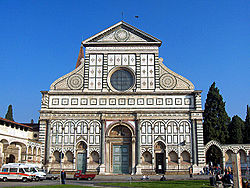
Two of Alberti’s best known buildings are in Florence, the Palazzo Rucellai and at Santa Maria Novella. For the palace, Alberti applied the classical orders of columns to the façade on the three levels, 1446-51. At Santa Maria Novella he was commissioned to finish the decoration of the façade. He completed the design in 1456 but the work was not finished until 1470.
The lower section of the building had Gothic niches and typical polychrome marble decoration. There was a large ocular window in the end of the nave which had to be taken into account. Alberti simply respected what was already in place, and the Florentine tradition for polychrome that was well established at the Baptistry of San Giovanni, the most revered building in the city. The decoration, being mainly polychrome marble, is mostly very flat in nature, but a sort of order is established by the regular compartments and the circular motifs which repeat the shape of the round window. For the first time, Alberti linked the lower roofs of the aisles to nave using two large scrolls. These were to become a standard Renaissance device for solving the problem of different roof heights and bridge the space between horizontal and vertical surfaces.
High Renaissance
In the late 15th century and early 16th century architects such as Bramante, Antonio da Sangallo the Younger and others showed a mastery of the revived style and ability to apply it to buildings such as churches and city palazzo which were quite different to the structures of ancient times. The style became more decorated and ornamental, statuary, domes and cupolas becoming very evident. The architectural period is known as the "High Renaissance" and coincides with the age of Leonardo, Michelangelo and Raphael.
Bramante
Donato Bramante, (1444-1514), was born in Urbino and turned from painting to architecture, found his first important patronage under Ludovico Sforza, Duke of Milan, for whom he produced a number of buildings over 20 years. After the fall of Milan to the French in 1499, Bramante travelled to Rome where he achieved great success under papal patronage.
Bramante’s finest architectural achievement in Milan is his addition of crossing and choir to the abbey church of Santa Maria delle Grazie. This is a brick structure, the form of which owes much to the Northern Italian tradition of square domed baptisteries. The new building is almost centrally planned, except that, because of the site, the chancel extends further than the transept arms. The hemispherical dome, of approximately 20 metres across, rises up hidden inside an octagonal drum pierced at the upper level with arched classical openings. The whole exterior has delineated details decorated with the local terracotta ornamentation.
In Rome Bramante created what has been described as "a perfect architectural gem", the Tempietto in the Cloister of San Pietro in Montorio. This small circular temple marks the spot where St Peter was martyred and is thus the most sacred site in Rome. The building adapts the style apparent in the remains of the Temple of Vesta, the most sacred site of Ancient Rome. It is enclosed by and in spatial contrast with the cloister which surrounds it. As approached from the cloister, as in the picture above, it is seen framed by an arch and columns, the shape of which are echoed in its free-standing form.
Bramante went on to work at the Vatican where he designed the impressive Cortili of St. Damaso and of the Belvedere. In 1506 Bramante’s design for Pope Julius II’s rebuilding of St. Peter’s Basilica was selected, and the foundation stone laid. After Bramante’s death and many changes of plan, Michelangelo, as chief architect, reverted to something closer to Bramante’s original proposal.
Sangallo
Antonio da Sangallo the Younger, (1485-1546), was one of a family of military engineers. His uncle, Giuliano da Sangallo was one of those who submitted a plan for the rebuilding of St Peter’s and was briefly a co-director of the project, with Raphael. Antonio da Sangallo also submitted a plan for St Peter’s and became the chief architect after the death of Raphael, to be succeeded himself by Michelangelo.

His fame does not rest upon his association with St Peter’s but in his building of the Farnese Palace, “the grandest palace of this period”, started in 1530. The impression of grandness lies in part in its sheer size, (56 m long by 29.5 meters high) and in its lofty location overlooking a broad piazza. It is also a building of beautiful proportion, unusual for such a large and luxurious house of the date in having been built principally of stuccoed brick, rather than of stone. Against the smooth pink-washed walls the stone quoins of the corners, the massive rusticated portal and the stately repetition of finely-detailed windows give a powerful effect, setting a new standard of elegance in palace-building. The upper of the three equally-sized floors was added by Michelangelo. It is probably just as well that this impressive building is of brick; the travetine for its architectural details came not from a quarry, but from the Colosseum.
Raphael
Raphael, (1483-1520), the famous High Renaissance painter from Urbino, trained under Perugino in Perugia before moving to Florence, was for a time the chief architect for St. Peter’s, working in conjunction with Antonio Sangallo. He also designed a number of buildings, most of which were finished by others. His single most influential work is the Palazzo Pandolfini in Florence with its two stories of strongly articulated windows of a "tabernacle" type, each set around with ordered pilasters, cornice and alternate arched and triangular pediments.
Mannerism
Mannerism was marked by widely diverging tendencies in the work of Michelangelo, Giulio Romano, Peruzzi and Andrea Palladio, that led to the Baroque style in which the same architectural vocabulary was used for very different rhetoric.
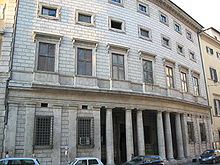
Peruzzi
Baldassare Peruzzi, (1481-1536), was an architect born in Siena, but working in Rome, whose work bridges the High Renaissance and the Mannerist. His Villa Farnesiana of 1509 is a very regular monumental cube of two equal stories, the bays being strongly articulated by orders of pilasters. The building is unusual for its frescoed walls.
Peruzzi’s most famous work is the Palazzo Massimo alle Colonne in Rome. The unusual features of this building are that its façade curves gently around a curving street. It has in its ground floor a dark central portico running parallel to the street, but as a semi enclosed space, rather than an open loggia. Above this rise three undifferentiated floors, the upper two with identical small horizontal windows in thin flat frames which contrast strangely with the deep porch, which serving, from the time of its building, as a refuge to the city’s poor.
Giulio Romano
Giulio Romano (1499-1546), was a pupil of Raphael, assisting him on various works for the Vatican. Romano was also a highly inventive designer, working for Federigo Gonzaga at Mantua on the Palazzo del Te, a project which combined his skills as architect, sculptor and painter. In this work he uses illusionistic effects, surprising combination of architectural form and texture and the frequent use of features that seem somewhat disproportionate or out of alignment. The total effect is eerie and disturbing. Ilan Rachum cites Romano as “one of the first promoters of Mannerism”
Michelangelo
Michelangelo Buonarroti (1475-1564), was one of the creative giants whose achievements mark the High Renaissance. He excelled in each of the fields of painting, sculpture and architecture and his achievements brought about significant changes in each area. His architectural fame lies chiefly in two buildings:- the interiors of the Laurentian Library and its lobby at the monastery of San Lorenzo in Florence, and the Basilica of St. Peter in Rome.
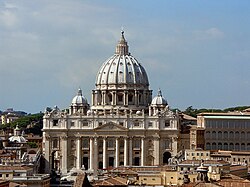
St. Peter's
St Peter's was "the greatest creation of the Renaissance", and a great number of architects contributed their skills to it. But at its completion, there was more of Michelangelo’s design than of any other architect, before or after him. The plan that was accepted at the laying of the foundation stone in 1506 was that by Bramante. Various changes in plan occurred in the series of architects that succeeded him, but Michelangelo, when he took over the project in 1546, reverted to Bramante’s Greek-cross plan and redesigned the piers, the walls and the dome, giving the lower weight-bearing members massive proportions and eliminating the encircling aisles from the chancel and identical transept arms. Helen Gardner says: "Michelangelo, with a few strokes of the pen, converted its snowflake complexity into a massive, cohesive unity."
Michelangelo’s dome was a masterpiece of design using two masonry shells, one within the other and crowned by a massive lantern supported, as at Florence, on ribs. For the exterior of the building he designed a giant order which defines every external bay, the whole lot being held together by a wide cornice which runs unbroken like a rippling ribbon around the entire building.
There is a wooden model of the dome, showing its outer shell as hemispherical. When Michelangelo died in 1564, the building had reached the height of the drum. The architect who succeeded Michelangelo was della Porta. The dome, as built, has a much steeper projection than the dome of the model. It is generally presumed that it was della Porta who made this change to the design, to lessen the outward thrust. But, in fact it is unknown who it was that made this change, and it equally possible, and in fact a stylistic likelihood that the person who decided upon the more dynamic outline was Michelangelo himself, at some time during the years that he supervised the project.
Laurentian Library
Michelangelo was at his most Mannerist in the design of the vestibule of the Laurentian Library, also built by him to house the Medici collection of books at the convent of San Lorenzo in Florence, the same San Lorenzo’s at which Brunelleschi had recast church architecture into a Classical mould and established clear formulae for the use of Classical orders and their various components.
Michelangelo takes all Brunelleschi’s components and bends them to his will. The Library is upstairs. It is a long low building with an ornate wooden ceiling, a matching floor and crowded with corrals finished by his successors to Michelangelo’s design. But it is a light room, the natural lighting streaming through a long row of windows that appear positively crammed between the order of pilasters that march along the wall. The vestibule, on the other hand, is tall, taller than it is wide and is crowded by a large staircase that pours out of the library in what Pevsner refers to as a “flow of lava”, and bursts in three directions when it meets the balustrade of the landing. It is an intimidating staircase, made all the more so because the rise of the stairs at the centre is steeper than at the two sides, fitting only eight steps into the space of nine.
The space is crowded and it is to be expected that the wall spaces would be divided by pilasters of low projection. But Michelangelo has chosen to use paired columns, which, instead of standing out boldly from the wall, he has sunk deep into recesses within the wall itself. In San Lorenzo's church nearby, Brunelleschi used little scrolling console brackets to break the strongly horizontal line of the course above the arcade. Michelangelo has borrowed Brunelleschi’s motifs and stood each pair of sunken columns on a pair of twin console brackets. Pevsner says the “Laurenziana… reveals Mannerism in its most sublime architectural form”.

Giacomo della Porta
Giacomo della Porta, (c.1533-1602), was famous as the architect who made the dome of St Peter’s Basilica a reality. The change in outline between the dome as it appears in the model and the dome as it was built, has brought about speculation as to whether the changes originated with della Porta or with Michelangelo himself.
Della Porta spent nearly all his working life in Rome, designing villas, palazzi and churches in the Mannerist style. One of his most famous works is the façade of the Church of il Gesù, a project that he inherited from his teacher Vignola. Most characteristics of the original design are maintained, subtly transformed to give more weight to the central section, where della Porta uses, among other motifs, a low triangular pediment overlaid on a segmental one above the main door. The upper storey and its pediment give the impression of compressing the lower one. The centre section, like that of Sant'Andrea at Mantua, is based on the Triumphal Arch, but has two clear horizontal divisions like Santa Maria Novella. The problem of linking the aisles to the nave is solved using Alberti’s scrolls, in contrasts to Vignola’s solution which provided much smaller brackets and four statues to stand above the paired pilasters, visually weighing down the corners of the building. The influence of the design may be seen in Baroque churches throughout Europe.
Andrea Palladio
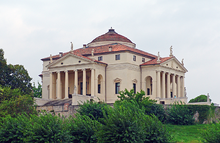
Andrea Palladio, (1518-80), "the most influential architect of the whole Renaissance"', was, as a stone mason, introduced to Humanism by the poet Giangiorgio Trissino. His first major architectural commission was the rebuilding of the Palazzo della Ragione at Vicenza, in the Veneto where he was to work most of his life.
Palladio was to transform the architectural style of both palaces and churches by taking a different perspective on the notion of Classicism. While the architects of Florence and Rome looked to structures like the Coliseum and the Arch of Constantine to provide formulae, Palladio looked to classical temples with their simple peristyle form. When he used the “triumphal arch” motif of a large arched opening with lower square-topped opening on either side, he invariably applied it on a small scale, such as windows, rather than on a large scale as Alberti used it at Sant’Andrea’s. This Ancient Roman motif is often referred to as the Palladian Arch.
The best known of Palladio’s domestic buildings is the Villa Capra, otherwise known as "la Rotonda", a centrally planned house with a domed central hall and four identical facades, each with a temple-like portico like that of the Pantheon in Rome.
Like Alberti, della Porta and others, in the designing of a church facade, Palladio was confronted by the problem of visually linking the aisles to the nave while maintaining and defining the structure of the building. Palladio’s solution was entirely different to that employed by della Porta. At the church of San Giorgio Maggiore in Venice he overlays a tall temple, its columns raised on high plinths, over another low wide temple façade, its columns rising from the basements and its narrow lintel and pilasters appearing behind the giant order of the central nave.
Baroque
In Italy, the Baroque style appears to flow seamlessly out of the Mannerist. Pevsner comments about the vestibule of the Laurentian Library that it "has often been said that the motifs of the walls show Michelangelo as the father of the Baroque".
While continuity may be the case in Italy, it was not necessarily the case elsewhere. The adoption of the Renaissance style of architecture was slower in some areas than in others, as may be seen in England, for example. Indeed, as Pope Julius II was having the ancient Basilica of St. Peter’s demolished to make way for the new, Henry VII of England was adding a glorious new chapel in the Perpendicular Gothic style to Westminster Abbey.
Likewise, the style that was to become known as Baroque evolved in Italy in the early 1600s, at about time that the first fully Renaissance buildings were constructed at Greenwich and Whitehall in England, after a prolonged period of experimentation with Classical motifs applied to local architectural forms, or conversely, the adoption of Renaissance structural forms in the broadest sense with an absence of the formulae that governed their use. While the English were just discovering what the rules were, the Italians were experimenting with methods of breaking them. After the building of the Banqueting Hall, English architecture moved rapidly in the direction of the Baroque. Rather than evolving, as it did in Italy, it arrived, fully fledged.
In a similar way, in many parts of Europe that had few purely classical and ordered buildings like Brunelleschi’s Santo Spirito and Michelozzo’s Medici Riccardi Palace, Baroque architecture appeared almost unheralded, on the heels of a sort of Proto-Renaissance local style. The spread of the Baroque and its replacement of traditional and more conservative Renaissance architecture was particularly apparent in the building of churches as part of the Counter Reformation.
Main article: Baroque architectureSpread of Renaissance architecture

Italy
Having its origins in Florence, the Renaissance spread throughout Tuscany, to Lombardy, Rome and beyond, with Alberti working in Mantua and Bramante in Milan. In 1499 the French captured Milan causing Bramante to flee to Rome, where he studied ancient ruins, and with these in mind designed some of the most important buildings of the High Renaissance period. In Venice, San Zaccaria received its Renaissance facade at the hands of Antonio Gambello and Mauro Codussi, begun in the 1480s. In Naples the Palazzo Orsini di Gravina was built by Gabriele d'Angelo in the Renaissance style between 1513 and 1549.
Beyond Italy
When the Renaissance spirit was exported into France, Spain, Portugal, England, the Low Countries, Germany, Poland, Sweden and Eastern Europe, it had to compromise with local traditions and climates, subsequently its phases are not so clearly distinguished in individual buildings.

France
Main article: French Renaissance architectureDuring the early years of the 16th century the French were involved in wars in northern Italy, bringing back to France not just the Renaissance art treasures as their war booty, but also stylistic ideas. In the Loire Valley a wave of building was carried and many Renaissance chateaux appeared at this time, the earliest example being the Château d'Amboise (c. 1495) in which Leonardo da Vinci spent his last years. The style became dominant under Francis I (See Châteaux of the Loire Valley).
England
Main article: Elizabethan architecture
Renaissance architecture arrived in England during the reign of Elizabeth I, having first spread through the Low countries where among other features it acquired versions of the Dutch gable, and Flemish strapwork in geometric designs adorning the walls. The new style tended to manifest itself in large square tall houses such as Longleat House.
The first great exponent of Renaissance architecture in England was Inigo Jones (1573–1652), who had studied architecture in Italy where the influence of Palladio was very strong. Jones returned to England full of enthusiasm for the new movement and immediately began to design such buildings as the Queen's House at Greenwich in 1616 and the Banqueting House at Whitehall three years later. These works, with their clean lines, and symmetry were revolutionary in a country still enamoured with mullion windows, crenelations and turrets.
Main article: Palladian architecture
Scandinavia
The Renaissance architecture that found its way to Scandinavia was (like the English) influenced by the Flemish architecture, and included high gables and a castle air as demonstrated in the architecture of Frederiksborg Palace. Consequently much of the Neo-Renaissance to be found in the Scandinavian countries is derived from this source.
Kingdom of Hungary
Main article: Renaissance architecture in Eastern Europe
One of the earliest places to be influenced by the Renaissance style of architecture was Hungary. The style appeared following the marriage of King Matthias Corvinus and Beatrix of Naples in 1476. Many Italian artists, craftsmen and masons arrived at Buda with the new queen. The most important work of Hungarian Renaissance ecclesiastical architecture is the Bakócz Chapel the in the, now rebuilt and mostly nineteenth century, Esztergom Basilica.

Spain
In Spain, Renaissance began to be grafted to Gothic forms in the last decades of the 15th century. The new style is called Plateresque, because of the extremely decorated facades, that brought to the mind the decorative motifs of the intricately detailed work of silversmiths, the “Plateros”. Classical orders and candelabra motifs (a candelieri) combined freely into symmetrical wholes.
From the mid-sixteenth century, under such architects as Pedro Machuca, Juan Bautista de Toledo and Juan de Herrera there was a closer adherence to the art of ancient Rome, sometimes anticipating Manierism, examples of which include the palace of Charles V in Granada and the Escorial.
Main article: Architecture of the Spanish Renaissance
Portugal
In Portugal, the Manueline style married Renaissance elements to Gothic structures. Later examples of Renaissance architecture in Portugal include the cathedrals of Leiria and Portalegre, the Jesuit college at Évora and the church of São Roque in Lisbon.
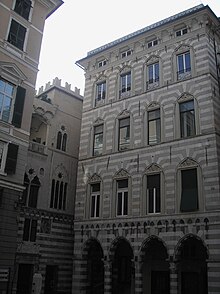
Legacy of Renaissance architecture
Many ideas in Renaissance architecture can be traced through subsequent architectural movements- from Renaissance to High-Renaissance, to Mannerism, to Baroque (or Rococo), to Neo-Classicism, to Eclecticism, to Modernism, and to Post-Modernism. The influence of Renaissance architecture can still be seen in many of the modern styles and rules of architecture today. During the 19th century there was a large Renaissance revival movement across Europe and North America.
See also
References
- Sir Banister Fletcher, A History of Architecture on the Comparative Method, first published 1896, current edition 2001, Elsevier Science & Technology ISBN 0750622679. Sir Banister describes it thus:- "The Renaissance in Italy may be divided broadly into three main periods, viz.: Early Renaissance- fifteenth century, High Renaissance and Proto-Baroque- sixteenth century, Baroque seventeenth and early eighteenth centuries." The term Mannerist is used in the present article rather than Proto-Baroque as being the one currently in more common use.
- Cropplestone, Trewin, World Architecture, 1963, Hamlyn. Page 243
- Robert Erich Wolf and Ronald Millen, Renaissance and Mannerist Art, 1968, Harry N. Abrams, ISBN not known
- Banister Fletcher
- Giovanni Fanelli, Brunelleschi, 1980, Becocci editore Firenze
- Ilan Rachum, The Renaissance, an Illustrated Encyclopedia, 1979, Octopus, ISBN 0706408578
- Banister Fletcher pp.678,681,683.
- Ilan Rachum
- Ilan Rachum
- Joseph Rykwert, Leonis Baptiste Alberti, Architectural Design, Vol 49 No 5-6, Hollland St, London
- Banister Fletcher
- Nikolaus Pevsner, An Outline of European Architecture, Pelican, 1964, ISBN unknown
- Ilan Rachum
- Banister Fletcher, p. 701.
- Banister Fletcher
- Ilan Rachum
- Banister Fletcher
- Banister Fletcher
- Banister Fletcher
- Banister Fletcher
- Ilan Rachum
- Banister Fletcher, p719
- Helen Gardner, Art through the Ages, 1970, Harcourt, Brace and World, Inc. ISBN 07679933
- Pevsner and Gardener suggest that Michelangelo began with the idea of a pointed dome, as in Florence, then in his old age reverted to the lower silhouette, and that della Porta stuck to Michelangelo's original concept. Mignacca, on the other hand, suggests that the pointed dome was Michelangelo's final, and brilliant, solution to the apparent visual tension within the building.
- Pevsner
- Ludwig Goldscheider, Michelangelo, 1964, Phaidon, ISBN unknown
- Banister Fletcher, p.738
- Ilan Rachum
- described by the architectural writer Sebastiano Serlio (1475–1554) in Tutte l'opere d'architettura et prospetivaref
- Manfred Wundram, Thomas Pape, Paolo Marton, Andrea Palladio, Taschen, ISBN 3822802719
- Banister Fletcher
- Pevsner
- Cropplestone, Trewin (1963). World Architecture. Hamlyn. Page 242
- Rákóczi Castle accessed 23 October 2006
- Image of Bakócz Chapel (1506-08)
- Seville Town Hall accessed 23 October 2006
External links
Template:Link FA Template:Link FA
Categories: